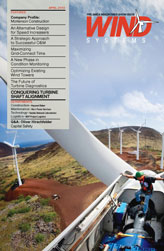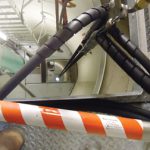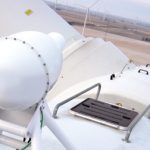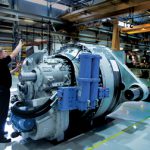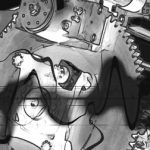The AWEA WINDPOWER show always provides impressive demonstrations of the latest and greatest achievements in all the areas of science and technology that are related to wind-power generation. Wind turbine gearbox suppliers present the very best gear alloys, forging and cutting processes, the mirror-like tooth surfaces achieved by the isotropic superfinish technology, and the best bearings and lubrication systems, etc.
In contrast with these innovations, the gear tooth geometry of almost all gearboxes has become outdated. In most cases it presents century-old tooth proportions produced by the standard 20o pressure angle generating racks with some addendum modification. This tooth geometry is universal and good for general gear applications because of gear interchangeability and the availability of standard tooling. It does not fit to the specific operating conditions and requirements of wind turbine gearboxes, however, which include a long lifetime of some 20 years, relatively low speeds, high static loads, size and weight constraints, high efficiency, noise and vibration limitations, and low cost of fabrication and maintenance, etc. The gear tooth geometry must be customized to satisfy all of these conditions.
Unlike the traditional standard gear design, the proposed alternative Direct Gear Design method does not use the basic rack parameters. It uses desired performance parameters and operating conditions to define the optimized gear tooth shape. This design approach is developed for involute gears and based on the theory of generalized parameters created by E.B. Vulgakov [1], and it can be defined as an application-driven gear drive development process with primary emphasis on performance maximization and cost efficiency without concern for any predefined tooling parameters.
Gear Tooth and Mesh Synthesis
There is no need for a basic gear rack to define the gear tooth profile. Two involutes of one base circle—or, in case of asymmetric gears, two different base circles—the arc distance between them and the tooth tip circle describe the gear tooth (see Fig. 1 A-B, Fig. 1 C-D) and the equally spaced teeth form the gear. The fillet between teeth is not in contact with the mating gear teeth. This portion of the tooth profile is critical, however, because this is the area of maximum bending stress concentration.
In a wind turbine gearbox the tooth load on one drive flank is significantly higher and is applied for longer periods of time than for the opposite coast one. An asymmetric tooth shape reflects this functional difference. The design intent of asymmetric gear teeth is to improve performance of the primary drive profiles at the expense of the performance for the opposite coast profiles. The coast profiles are unloaded or lightly loaded during relatively short work period. Asymmetric tooth profiles also make it possible to simultaneously increase the contact ratio and operating pressure angle beyond conventional gear limits. The main advantage of asymmetric gears is contact stress reduction on the drive flanks, resulting in higher torque density, or load capacity per gear size. Another important advantage is the possibility to design the coast flanks and fillet independently from the drive flanks, managing tooth stiffness and load sharing while keeping a desirable pressure angle and contact ratio on the drive profiles. This allows reducing gear noise and vibration level. Asymmetric gears make it possible to simultaneously increase the transverse contact ratio and operating pressure angle far beyond conventional gear limits [2].
Tooth Fillet Profile Optimization
The tooth fillet design begins when the involute flank parameters are completely defined. The initial fillet profile is a trajectory of the mating gear tooth tip in the tight, zero-backlash mesh. The fillet optimization process [3] utilizes three methods: random search method locating fillet points; trigonometric functions for fillet profile approximation; and FEA for stress calculation.
The first and the last fillet profile points of the initial fillet profile lay on the form diameter circles (Fig. 2A, Fig. 2B) and can’t be moved during an optimization process. The random search method is used to move the fillet finite element nodes along the beams that connect the fillet center and the nodes of the initial fillet profile.
The bending stresses are calculated for every new fillet profile points’ combination. If the maximum bending stress is reduced, the program continues searching in the same direction. If not, it steps back and starts searching in a different direction. After the given number of iteration steps the optimization process is stopped, resulting in the optimized fillet profile that provides minimum bending stress concentration. Table 1 illustrates fillet profile optimization and the achievable maximum bending stress reduction for standard AGMA 201.2 gears.
The 20-25 percent bending stress reduction provided by the fillet profile optimization can be used directly to increase the tooth bending strength if it limits the gear drive load capacity. However, the gear drive load capacity and its size and weight are typically defined by the contact stress, or tooth surface durability. In this case the benefit of the bending stress reduction can be converted to reduce the contact stress and simultaneously increase gear mesh efficiency [4]. This is possible by increasing the number of teeth and applying the finer diametral pitch (lesser module) for the teeth with optimized filler, keeping the given center distance.
Table 2 presents a comparison of the traditionally designed gear pair with the 27-tooth pinion and the 49-tooth gear, the 3 mm module, and the 32 and 30 mm face widths for the pinion and gear accordingly with similar gear pairs created by Direct Gear Design with the symmetric and asymmetric tooth profiles. This table illustrates the contact and bending stress reduction and increased mesh efficiency for direct design gears. Fig. 3 presents the carrier assembly of a two-stage planetary turboprop engine [5]. Application of asymmetric gears allowed significant weight-output torque reduction in comparison with similar gearboxes with conventional symmetric gears.
Optimized gear profiles require custom tooling. For profile machining process (Fig. 4) the tool profile is the same as a space profile between the neighboring teeth. For generating machining process like gear hobbing (Fig. 4) the tool profile is defined by reverse generation when the designed gear forms the tooling rack profile. In this case the rack profile (pressure) angles are selected to provide the best machining conditions.
Summary
Unlike traditional gear design, which is based on the rack generating process and driven by manufacturing convenience, Direct Gear Design is driven entirely by application requirements, when technical and market performance of product is critical. It provides the ultimate in optimized gear geometry solutions for custom gear transmissions such as wind turbine gearboxes. The benefits of this approach include higher load capacity, reduced size and weight, extended lifetime, reduced noise and vibration, higher efficiency and reliability, and reduced cost. AKGears has implemented direct gear design in many high-performance gear drives, and we welcome your inquiries.
References:
1) E.B. Vulgakov, Gears with Improved Characteristics, Mashinostroenie, Moscow, 1974 (in Russian).
2) A.L. Kapelevich, “Geometry and design of involute spur gears with asymmetric teeth”, Mechanism and Machine Theory, 2000, Issue 35, pp. 117-130.
3) A.L. Kapelevich, Y.V. Shekhtman, Tooth Fillet Profile Optimization for Gears with Symmetric and Asymmetric Teeth, AGMA Fall Technical Meeting, San Antonio, Texas, October 12-14, 2008, (08FTM06).
4) A.L. Kapelevich. Direct Design for High-Performance Gear Transmissions, Gear Solutions, December 2008, 22-31.
5) A.S. Novikov, A.G. Paikin, V.L. Dorofeyev, V.M. Ananiev, A.L. Kapelevich, Application of Gears with Asymmetric Teeth in Turboprop Engine Gearbox, Gear Technology, January/February 2008, 60-65.



















